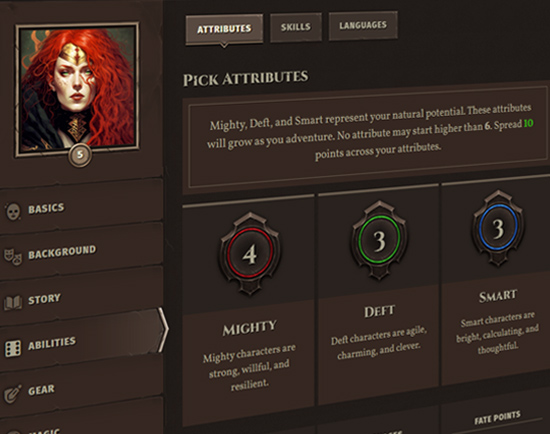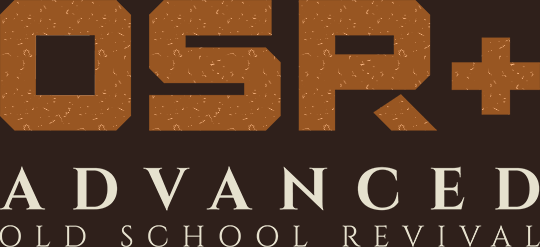Session Breakdown
A session of OSR+ can be broken down into 3 distinct phases, starting with out-of-character housekeeping and ending with a three-act approach to running the adventure itself.
- Housekeeping (~10m). The game loop of an OSR+ session begins with the housekeeping step, where you address any out-of-character issues, provide a recap of the previous session, and narrate an optional precap that presages things to come.
- Overworld Action (~30m). Then (if your campaign supports it), you transition into overworld action, where players decide what is happening in the game world at large, outside their individual PC's perspectives.
- Act I-III (45m+ each). Finally, we enter gameplay in one of the three game modes: downtime, encounter, or exploration, the choice of which depends on the needs of the scene the players are engaging with.
For example, if the doorway scene of the adventure is the heat of battle, play might start as an encounter; alternatively, if the doorway scene takes place during a royal ball, play begins as a downtime where PCs engage with NPC masqueraders or each other.
For ongoing adventures, you always pick up where you left off, whether that's mid-scene or at the start of a new one.
Housekeeping
At the start of each session, address any out-of-character concerns: for example, mistakes you made as a GM in the last session that you want to correct for going forward, or praise you have for the table for what they’ve accomplished thus far. Be careful about focusing on one player's accomplishments in isolation, unless you have something positive to say about everyone at the table.
You can award fate points for exceptional roleplaying (whether that's for clever ideas or exceptional improv), and remind players of any unique mechanics in your campaign. Remember, this is the last chance to talk to the players out of character before you enter the game.
The Recap
A recap is when you spend a few minutes discussing the events of the previous session. You can do it yourself from your notes, or you can go around the table and ask each player to discuss something that stood out to them, or something they felt important from the last session. (But keep it brief; don't let anyone drone on too long!)
Purpose of a Recap
The point of the recap is to highlight events from the previous session that you as the GM think are narratively important, not necessarily to give a summary of what happened. Plot summaries are boring to recite and boring to listen to. Think about how when you watch the recap of a TV show ahead of the next episode, you only hear key lines of dialogue that characterize themes rather than events, or clips of dramatic scenes that remind you about sources of the conflict.
Benefits of Recapping
Overall, the recap is an opportunity to highlight what you think is the shape of the emerging narrative, and if there is a mystery afoot, to draw attention to any clues the PCs surfaced in the last session.
Players tend to remember things they find personally interesting. When you ask players to mention anything you forgot to mention, you’re really looking to learn more about what’s important to them, so you can add more of that to future sessions.
The Precap
Precaps, on the other hand, are a means of giving the players insight into what is happening in the world outside the PCs' perspective.
What the precap reveals is always out-of-character knowledge that should be presented to players in a cryptic and cinematic way. Use camera techniques to describe the action in a precap, as if the players are watching a movie, but be sure to describe what is happening rather than narrate, as if you too are uninformed of what exactly is being depicted:
"The camera pans upward to the peak of the Tower of Blue Wards; you see a Nim in voluminous purple robes peer down at the courtyard, his eyes glinting yellow with a sinister gaze…”
It might be obvious that the Nim is Archmage Mergrim Mennetestor, but we never name him, because the camera can only show the players what is happening—it can’t tell them anything directly.
Overworld Action
Not every campaign has overworld action, where you consult the world map to see what's going on with the factions in play. For example, in Magic University (which is about the college lives of apprentice wizards) overworld action determines what's happening in the University at large and how it impacts each PC, rather than the political alliances of warring factions, as might be the case in a game like A Quest of Queens, which is a epic fantasy campaign.
If you do have overworld action in your game, you don't want to spend too much time there, unless everyone at the table really loves pen and paper Civilization. Ultimately, the purpose of the overworld is immersion: more context for the fiction means more context for the PCs. Even though the overworld is concerned with what's happening outside the point of view of the PCs, those things that are happening have to be somehow relevant to the PCs, otherwise the players will lose interest in the whole experience.
The 3-Act Session
Once you're past housekeeping and overworld action, you enter play in one of the game modes and get right down to business.
Adventure Cadence
There's a certain cadence to each session that's often dictated by the feel of the fiction. And by "feel of the fiction" we mean the combination of the mood of your setting, its genre, and the tone you're going for.
A thrilling Indiana Jones action-adventure with brash, funny characters might have a frenetic pace to it, even in exploratory scenes, and you might cover a whole lot of ground in act I—an hour and a half bounding through several scenes—then segue into a 20-minute act II that punctuates the session with a brief downtime. A final act III might include an intricate set piece as an encounter that's full of perils and takes an hour to resolve.
On the other hand, a dark fantasy steeped in court intrigue might cover far less physical ground but be so immersive that it feels like it's accomplished just as much in the narrative. In act I, players might have a lengthy, hour-long downtime of a dark ritual via a montage, which segues into act II's terrifying exploration of a bone-encrusted catacomb beneath the city. Perhaps there is a brief struggle with undead during that exploration, constituting a 15-minute switch to encounter mode to resolve it. All-in-all, there may not be much action-adventure going on in this kind of game, but the players may have had a psychological voyage all the same, within the PCs' interiors.
Structuring Acts
If the players have control over which scenes they navigate to in a non-linear adventure, how can the GM structure the session in three distinct acts?
Despite players’ agency to choose where they want to go and what they want to do based on the adventure hooks they discover, you have a number of structural tools at your disposal to control the cadence of the adventure.
pUNCTUATE THE aDVENTURE WITH dOWNTIME
First, you can create lots of floating scenes that are structured as downtimes, which you can deploy strategically when players move between scenes that contain similar game modes. For example, if they've just finished an encounter scene and they're about to stumble into another one, it might be time to run that floating flashback you had in your back pocket, as a form of punctuation.
Choose Resolution Mechanics Strategically
Managing the cadence of the adventure means you have to have your eye on the clock. Remember, you get to decide which mechanics resolve what actions players take as they navigate a scene. If they've already spent an hour exploring a scene and their next choice of scene was designed as another hour-long exploration, you can always resolve the next scene as a scene check, to shorten the play time out-of-game. You can also do the same thing within a scene to end it quicker than you anticipated.
In this regard, constraining each set piece (whether that's a single scene or a series of scenes) to no longer than one-third of the total session's duration, is a good rule of thumb in creating a successful adventure cadence.
 Archetypes
Archetypes Armor
Armor Classes
Classes Conflicts
Conflicts Cultures
Cultures Ethos
Ethos Flaws
Flaws Glossary
Glossary Kits
Kits Maleficence
Maleficence Origins
Origins Shields
Shields Skills
Skills Spells
Spells Stances
Stances Status Effects
Status Effects Tactics
Tactics Talents
Talents Techniques
Techniques Treasure
Treasure Weapons
Weapons











 Hall of Heroes
Hall of Heroes Hall of Legends
Hall of Legends



 Dungeons & Flagons
Dungeons & Flagons